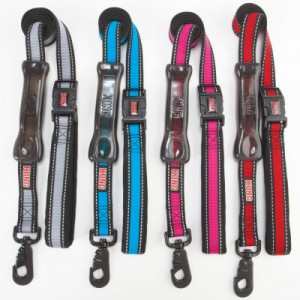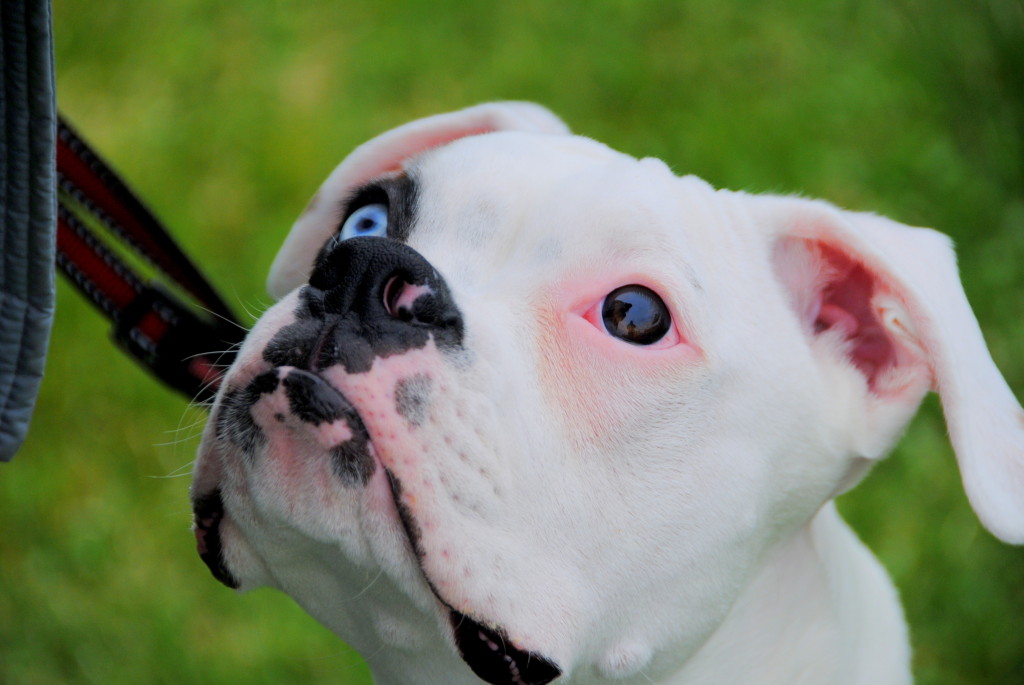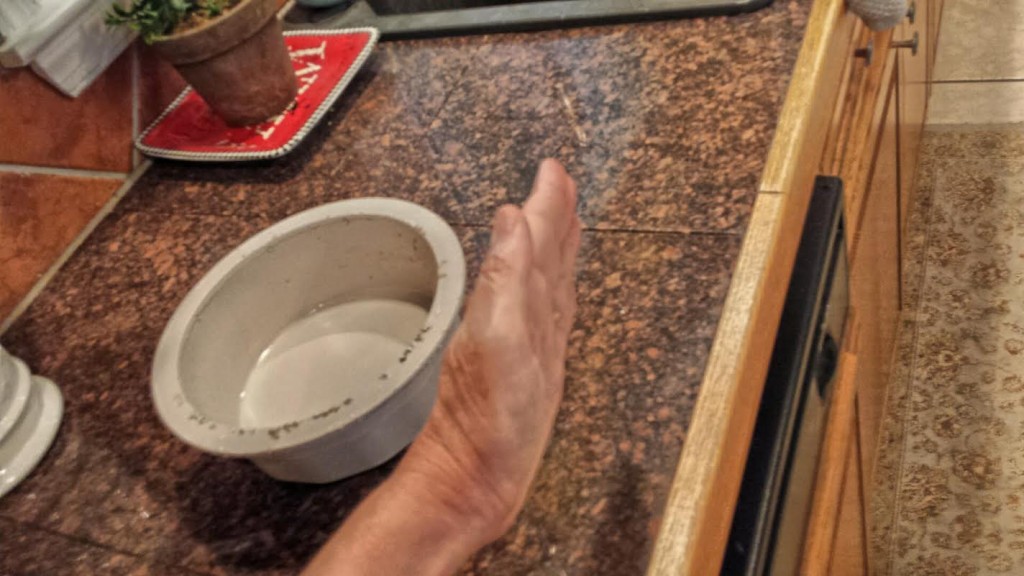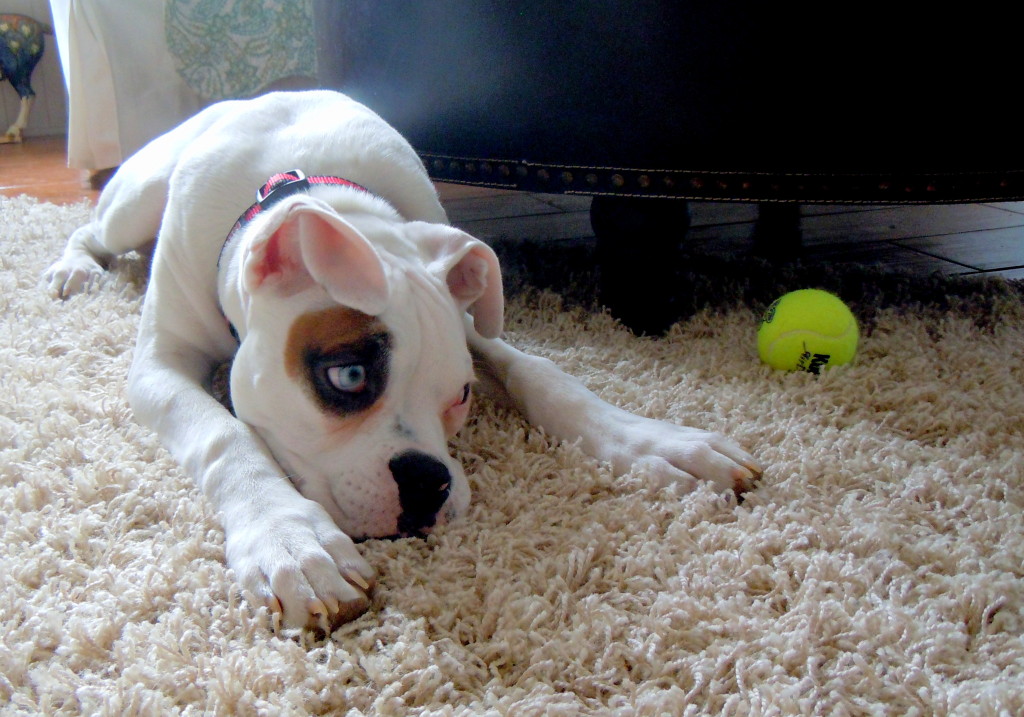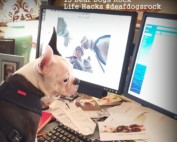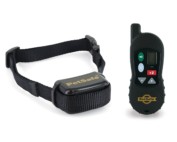Lately I have been getting a lot of emails and messages concerning deaf dogs playing rough with the other dogs in the home. I also get messages coming from new deaf dog owners stating that their new dog seems to bite way too hard. My advice is to really be consistent by working on bite inhibition training every chance you get. With positive reinforcement training and consistency your dog will understand bite inhibition using the “gentle” and “leave it” sign cues in no time at all.
Because I have four deaf dogs and two hearing dogs here at the Deaf Dogs Rock Headquarters, I have worked very hard training all my dogs on the “gentle” and “leave it” sign cues. I am going to share with you what has worked for me here on the farm with my e deaf dogs Nitro, Bud, (both big boxers), my deaf Boston Terrier Bowie, my deaf heeler Cornell and my two tiny dogs Pepe and Tallulah.
All four of my deaf dogs can safely play with my little dogs because of consistent positive reinforcement training over the years. Sometimes I will see two of my big dogs playing and my little 10 pound dog Tallulah will jump right into the mix and play also. I make sure I always monitor their play times 100% of the time so they always remain safe. Here are a few of my personal training tips and also my two favorite training videos on each subject.
The first video is on puppy mouthing and bite inhibition by Victoria Stilwell. You can tweak your training when working with your deaf dog by teaching your dog the “gentle” sign and a using a sad expression on your face in place of the sound of yelping that Victoria uses in this video.
Above: I use the “gentle” sign by rubbing one hand over the other very slowly so they know I mean “gentle”.
The second video is by Tab 289 on YouTube. He is wonderful at teaching dogs the “leave it” cue. You will also tweak the training from this video by using a “leave it” sign and a thumbs up or open flash of your hand instead of the sound of a clicker to mark the correct response from your deaf dog.
Happy training! ~ Christina Lee – Deaf Dogs Rock
Here is one of my favorite training videos from Victoria Stilwell on Puppy Mouthing
The best time to work on bite inhibition training is when you have time to sit on the floor with your deaf puppy or dog and encourage gentle play. Use you hands to get started by using them in a playful matter. The slight training tweak you will make in your training program from the video above is you will use a facial expression of a sad face and rub one hand slowly over the other for the “gentle” sign. If your deaf pup bites too hard, then make a sad face, give the “gentle” sign and if he starts to play gentle by backing off a little, give your pup a big smile and a thumbs up sign for “good dog”. If after you give the “gentle” sign the pup gets even more excited or continues to bite down hard,then sign “no”, next sign “gentle” and get up and walk away immediately. When a deaf dog or puppy bites down hard ALL FUN STOPS! You can walk away for 10 or 15 seconds and then return and start all over again.
If you have a dog who is constantly running up to you and nipping at your hands and heels, it is always a good idea to redirect with one of your pup’s favorite toys. Also think about rewarding good behavior with a special toy you bring out when your deaf dog/puppy is biting softly (as a reward). When your deafie is being gentle be sure to reward the behavior with lots of praise (smiling and a thumbs up sign).
Be sure to reinforce your training with always walking away immediately from the dog when he bites down to hard. Go into another room or go outside. Please consider that even negative attention is attention to a dog. If you are out and about and your dog starts biting the leash or your hand, consider getting a leash with a clip at both ends so you can clip your dog to something sturdy nearby and practice walking away and approaching the dog over and over until the dog gets your message.
When I first started training my deaf dogs Nitro, Bud and Bowie with bite inhibition training, I would sit on the living room floor to engage them in playing but when they continued to bite too hard, I would immediately get up and walk down the hallway and close the doggy gates behind me so the dogs could not follow me. All attentions stops. I would wait a short time, 15-30 seconds and then try again.
Once my deaf dog understands what the “gentle” sign means then I start to work on “leave it”. Most dogs will pick up the “leave it” sign cue very fast when using a high value treat. I start with “watch me” training to make sure the dog checks in with me often. Every time the dog makes eye contact with me, I give a “thumbs up” sign or an open flash of my hand (instead of the sound of a clicker) and then I would give the dog a treat. Repeat, repeat, repeat.
Next I hold the high value treat in my hand and give the “leave it” sign which is a karate chop motion with my hand up and down between the object I want my deaf dog to leave and my dog’s face. I leave the treat in my hand and when my deaf dog tries to grab the treat out of the palm of my hand, I give the “leave it” sign. I then close my hand every time the dog tries to take the treat from me. Within a minute or two the dog will figure out he gets the treat when he backs up and makes eye contact with me. When my dog backs away from the treat, makes eye contact with me (some dogs will even sit down and look directly at you), then I smile, give a thumbs up sign (instead of the sound of a clicker), and then give my dog the treat. Repeat, repeat, repeat.
Above: For the “leave it” sign I do an up and down karate chop motion in between the dog and the object (in this photo the object is the food bowl).
The leave it training is a very important sign cue to learn. It can be used in the event of an emergency for example if I was to spill a bottle of prescription meds on the floor. I could give the “leave it” sign for my deaf dogs and they would not touch any of the pills on the floor. My deaf dog Nitro has been taught the “leave it” sign with treats, toys and other dogs. I can take him to a dog park and if I see another dog behaving badly I can point at that particular dog, tell Nitro to “leave it” and he will stay away from the dog I am pointing at.
To view the Leave it training cue by Savvy Dog Training done in American Sign Language, please click here.
Here is one of my favorite “leave it” videos on YouTube by Tab289. You will tweak the verbal training by changing to sign training. You can use a open flash of your hand or a thumbs up sign in place of the sound of the clicker (to mark the correct behavior). Remember to smile and praise your deaf dog when he starts to get the “leave it” sign cue. Deaf dogs are very tuned into our facial expressions and body language. You can take this wonderful training a stop further by training your deaf dog to leave treats, toys, house hold items, and other animals in your home.
Since I have four deaf dogs and three of them are rather large dogs, I had to teach them to play “gentle” with my small dogs. When I got Bud he was an un-neutered 50 pound boxer and I had to teach him to leave my senior dog Lexi alone. How did I do it? Every single time he approached her I would point to her and tell him to “leave it” and keep him moving forward to pass her.
For my 10 pound dog Tallulah, I sat on the floor with both Bud and Tallulah and engaged them in playing together. I was very hands on with my hands engaging both dogs this way I could tell if Bud was getting to rough with Tallulah or not. When Bud would get rough with Tallulah, I would give him the “gentle” sign and then give him another opportunity to play with her. If he continued being rough with her, all play would STOP and I would pick Tallulah up and go into another room. ALL PLAY and ATTENTION STOPS! Repeat, repeat, repeat as often as you can. Also if Bud where to place a paw on top of Tallulah’s back, all play would stop. Before long he started laying down on the floor to play with her and he did so gently. To this day he is so gentle with Tallulah.
Three years ago we rescued a 6 pound senior Chihuahua and Bud has been surprisingly gentle with him because of all of his “gentle” sign training I did with him earlier.
You don’t have to use aversive training techniques when training your deaf dog or puppy bite inhibition. If you do use aversive training techniques you will see your puppy fight back, get aroused and in many cases the puppy will get so wound up he/she will nip harder than before. It really is as simple as total withdrawal of attention. Sometimes it is a matter of me removing myself for a minute or two and sometimes it is a matter of removing the other dog engaged in playing with my deaf dog. You can remove yourself or another dog from 10 to 20 seconds up to a minute and then return to resume play time.
If you have two older dogs playing for example, one hearing and one deaf dog, and you realize your deaf dog is not picking up your hearing dog’s growl or “back off” cues, make sure ALL PLAY STOPS! Be sure you monitor all of your dog’s when they are playing inside/outside together. Follow up often with the “gentle” sign when dogs are rough housing. You can even do a short “time out” by splitting them up for a minute or two. Give them the “time out” sign and do a short break.
When they resume playing, be sure to give them a “gentle” sign to give them another chance to take their rough housing down a notch or two. Sometimes I walk right up to my deaf boxer Bud, tap him on the shoulder, point to Nitro, and give Bud the “gentle” sign. I am very specific with what I am requesting and signing to my deaf dogs. You will discover sometimes one of your dogs seems to have a lot more energy than the other dog so it can help the situation to have some “redirection” ideas in your back pocket. Click here to see our post on Redirection.
Please Read:
Please consider if your dog is having serious behavioral issues, please contact a professional for an evaluation and tips on how you can improve your situation. The tips shared here are from my personal experience and I am not a professional trainer. Nothing I write on this blog can take place of a meeting with a trained K-9 dog training professional. Also if you have an un-neutered puppy they sometimes have so much testosterone running through their veins they are much easier to become aroused and be very nippy.
Nothing on this website or any tips given by Deaf Dogs Rock or Christina Lee will be held responsible for any incidents related directly or indirectly to the materials published on DeafDogsRock.com. Christina Lee or DeafDogsRock.com assumes no liability or responsibility for any of your actions taken after reading our published material on this site.



